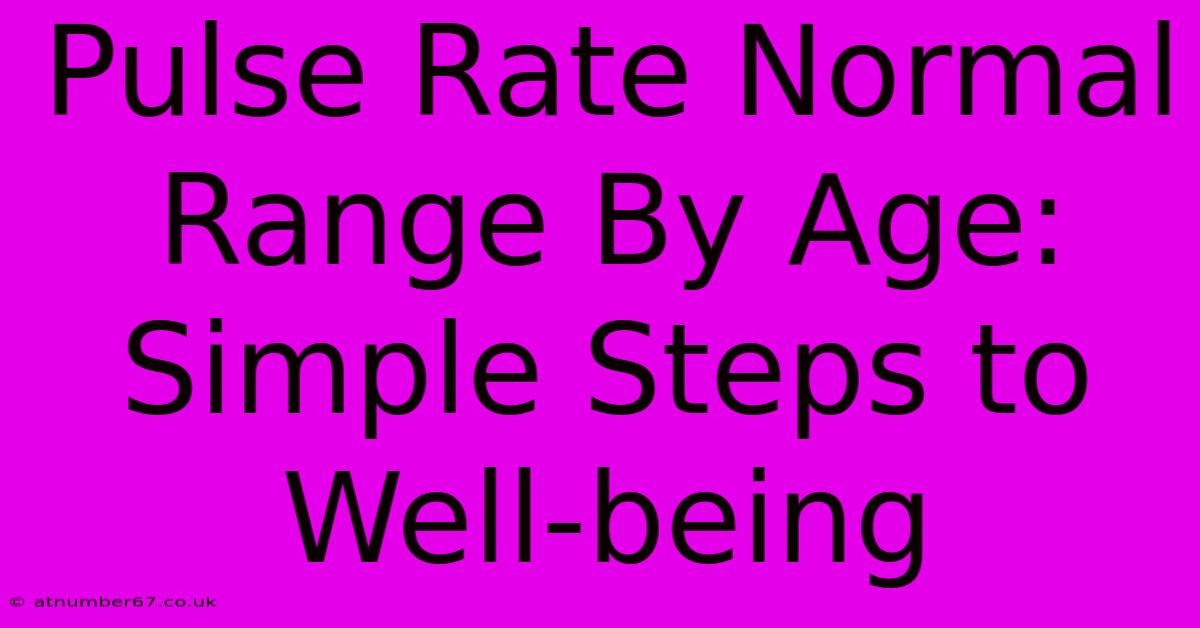Pulse Rate Normal Range By Age: Simple Steps To Well-being

Table of Contents
Pulse Rate Normal Range By Age: Simple Steps to Well-being
Understanding your pulse rate is a crucial step towards achieving overall well-being. Your pulse, or heart rate, reflects how efficiently your heart is pumping blood throughout your body. Knowing the normal pulse rate range for your age allows you to monitor your health, identify potential problems early, and make informed decisions about your lifestyle. This comprehensive guide will explore the normal pulse rate ranges by age, factors influencing heart rate, and simple steps you can take to maintain a healthy heart.
Understanding Your Pulse Rate
Your pulse rate is simply the number of times your heart beats per minute (BPM). You can easily check your pulse by placing your index and middle fingers on your wrist (radial artery) or neck (carotid artery). Count the beats for 60 seconds to determine your BPM. A slightly more efficient method is to count the beats for 30 seconds and multiply by two.
Why is Knowing Your Pulse Rate Important?
Regularly monitoring your pulse rate provides valuable insights into your cardiovascular health. A consistently high or low pulse rate can indicate underlying health issues, such as:
- High pulse rate (tachycardia): Can be caused by stress, anxiety, dehydration, fever, heart conditions, or medications.
- Low pulse rate (bradycardia): Can be caused by certain medications, heart conditions, or electrolyte imbalances.
Normal Pulse Rate Ranges by Age
The normal pulse rate range varies depending on age, fitness level, and overall health. Here's a general guideline:
Infants (0-1 year):** 70-190 BPM**
Toddlers (1-2 years):** 90-150 BPM**
Preschoolers (3-5 years):** 80-140 BPM**
Children (6-12 years):** 70-120 BPM**
Adolescents (13-18 years):** 60-100 BPM**
Adults (18+ years):** 60-100 BPM**
Note: Highly trained athletes often have resting heart rates significantly lower than the average adult range.
Factors Affecting Pulse Rate
Several factors can influence your pulse rate, including:
- Age: As mentioned above, your pulse rate naturally changes with age.
- Physical activity: Exercise temporarily increases your pulse rate.
- Medications: Certain medications can affect your heart rate.
- Stress and anxiety: Stress hormones can elevate your pulse rate.
- Dehydration: Lack of fluids can increase your heart rate.
- Body temperature: Fever increases your pulse rate.
- Underlying health conditions: Heart conditions, thyroid problems, and other illnesses can impact your pulse rate.
Simple Steps to Maintain a Healthy Pulse Rate
Maintaining a healthy pulse rate involves adopting a healthy lifestyle. Here are some key steps:
1. Regular Exercise:** Aim for at least 150 minutes of moderate-intensity or 75 minutes of vigorous-intensity aerobic activity per week.**
2. Balanced Diet:** Consume a diet rich in fruits, vegetables, whole grains, and lean proteins. Limit processed foods, sugary drinks, and unhealthy fats.
3. Stress Management:** Practice stress-reducing techniques such as yoga, meditation, or deep breathing exercises.
4. Adequate Sleep:** Aim for 7-9 hours of quality sleep per night.
5. Hydration:** Drink plenty of water throughout the day.
6. Avoid Smoking and Excessive Alcohol Consumption:** These habits negatively impact cardiovascular health.
7. Regular Check-ups:** Schedule regular check-ups with your doctor to monitor your overall health, including your pulse rate and blood pressure.
When to See a Doctor
If you experience a consistently high or low pulse rate, dizziness, chest pain, shortness of breath, or other concerning symptoms, consult your doctor immediately. Don't hesitate to seek medical advice if you have any concerns about your heart health.
Conclusion
Understanding your normal pulse rate range is vital for maintaining good health. By following the simple steps outlined above and paying attention to your body, you can take proactive steps towards a healthier and longer life. Remember, regular monitoring and a healthy lifestyle are key to maintaining a healthy heart and a strong pulse.

Thank you for visiting our website wich cover about Pulse Rate Normal Range By Age: Simple Steps To Well-being. We hope the information provided has been useful to you. Feel free to contact us if you have any questions or need further assistance. See you next time and dont miss to bookmark.
Featured Posts
-
Manage Your Finances Like A Pro Son Ekstreden Kalan Borc
Apr 06, 2025
-
Ruth Elliss Son A Familys Untold Story
Apr 06, 2025
-
Pharaohs Daughters Bold Decision
Apr 06, 2025
-
Unveiling The Mystery Paul Mersons Son
Apr 06, 2025
-
Shah Rukh Khan Age A Closer Look At His Longevity
Apr 06, 2025
